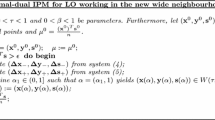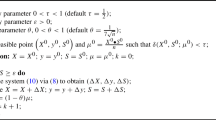Abstract
When we apply interior point algorithms to various problems including linear programs, convex quadratic programs, convex programs and complementarity problems, we often embed an original problem to be solved in an artificial problem having a known interior feasible solution from which we start the algorithm. The artificial problem involves a constantℳ (or constants) which we need to choose large enough to ensure the equivalence between the artificial problem and the original problem. Theoretically, we can always assign a positive number of the order O(2L) toℳ in linear cases, whereL denotes the input size of the problem. Practically, however, such a large number is impossible to implement on computers. If we choose too largeℳ, we may have numerical instability and/or computational inefficiency, while the artificial problem withℳ not large enough will never lead to any solution of the original problem. To solve this difficulty, this paper presents “a little theorem of the bigℳ”, which will enable us to find whetherℳ is not large enough, and to updateℳ during the iterations of the algorithm even if we start with a smallerℳ. Applications of the theorem are given to a polynomial-time potential reduction algorithm for positive semi-definite linear complementarity problems, and to an artificial self-dual linear program which has a close relation with the primal—dual interior point algorithm using Lustig's limiting feasible direction vector.
Similar content being viewed by others
References
K.M. Anstreicher, “A combined phase I—phase II projective algorithm for linear programming,”Mathematical Programming 43 (1989) 209–223.
R.M. Freund, “Theoretical efficiency of a shifted barrier function algorithm for linear programming,”Linear Algebra and its Applications 152 (1991) 19–41.
G. de Ghellinck and J.-P. Vial, “A polynomial Newton method for linear programming,”Algorithmica 1 (1986) 425–453.
S. Karamardian, “The nonlinear complementarity problem with applications, I and II,”Journal of Optimization Theory and Applications 4 (1969) 87–98 and 167–181.
M. Kojima, N. Megiddo and S. Mizuno, “A general framework of continuation methods for complementarity problems,” RJ 7720, IBM Almaden Research Center (San Jose, CA, 1990).
M. Kojima, N. Megiddo and S. Mizuno, “Theoretical convergence of large-step primal—dual interior point algorithms for linear programming,”Mathematical Programming 59 (1993) 1–21.
M. Kojima, N. Megiddo, T. Noma and A. Yoshise, “A unified approach to interior point algorithms for linear complementarity problems,”Lecture Notes in Computer Science No. 538 (Springer, Berlin, 1991).
M. Kojima, N. Megiddo and Y. Ye, “An interior point potential reduction algorithm for the linear complementarity problem,”Mathematical Programming 54 (1992) 267–279.
M. Kojima, S. Mizuno and A. Yoshise, “A primal—dual interior point algorithm for linear programming,” in: N. Megiddo, ed.,Progress in Mathematical Programming, Interior-Point and Related Methods (Springer, New York, 1988) pp. 29–48.
M. Kojima, S. Mizuno and A. Yoshise, “A polynomial-time algorithm for a class of linear complementary problems,”Mathematical Programming 44 (1989) 1–26.
M. Kojima, S. Mizuno and A. Yoshise, “An O(\(\sqrt n \) L) iteration potential reduction algorithm for linear complementarity problems,”Mathematical Programming 50 (1991) 331–342.
I.J. Lustig, “Feasibility issues in a primal—dual interior-point method for linear programming,”Mathematical Programming 49 (1990/91) 145–162.
I.J. Lustig, R.E. Marsten and D.F. Shanno, “Computational experience with a primal—dual interior point method for linear programming,”Linear Algebra and its Application 152 (1991) 191–222.
O.L. Mangasarian and L. McLinden, “Simple bounds for solutions of monotone complementarity problems and convex programs,”Mathematical Programming 32 (1985) 32–40.
K.A. McShane, C.L. Monma and D.F. Shanno, “An implementation of a primal—dual interior point method for linear programming,”OSRA Journal on Computing 1 (1989) 70–83.
N. Megiddo, “A monotone complementarity problem with feasible solutions but no complementary solutions,”Mathematical Programming 12 (1977) 131–132.
N. Megiddo, “Pathways to the optimal set in linear programming,” in: N. Megiddo, ed.,Progress in Mathematical Programming, Interior-Point and Related Methods (Springer, New York, 1988) pp. 131–158.
S. Mizuno, “A new polynomial time method for a linear complementarity problem,”Mathematical Programming 56 (1992) 31–43.
S. Mizuno and M.J. Todd, “An O(n 3 L) long step path following algorithm for a linear complementarity problem,” Technical Report No. 23, Department of Industrial Engineering and Management, Tokyo Institute of Technology, Oh-Okayama, Meguro-ku (Tokyo, Japan, 1989).
R.D.C. Monteiro and I. Adler, “Interior path following primal—dual algorithms. Part I: linear programming,”Mathematical Programming 44 (1989) 27–41.
J.J. Moré, “Class of functions and feasibility conditions in nonlinear complementarity problem,”Mathematical Programming 6 (1974) 327–338.
T. Noma, “A globally convergent iterative algorithm for complementarity problems—A modification of interior point algorithms for linear complementarity problems,” Dr. thesis, Department of Systems Sciences, Tokyo Institute of Technology, Oh-Okayama, Meguro-ku (Tokyo, Japan, 1991).
M.J. Todd, “Combining phase I and phase II in a potential reduction algorithm for linear programming,”Mathematical Programming 59 (1993) 133–150.
Y. Ye, “A low complexity combined phase I—phase II potential reduction algorithm for linear programming,” Working Paper Series No. 91-1, Department of Management Sciences, College of Business Administration, The University of Iowa (Iowa City, IA, 1991).
R.J. Vanderbei and T.J. Carpenter, “Symmetric indefinite systems for interior-point methods,” Technical Report SOR-91-7, Department of Civil Engineering and Operations Research, Princeton University (Princeton, NJ, 1991).
Author information
Authors and Affiliations
Rights and permissions
About this article
Cite this article
Kojima, M., Mizuno, S. & Yoshise, A. A little theorem of the bigℳ in interior point algorithms. Mathematical Programming 59, 361–375 (1993). https://doi.org/10.1007/BF01581253
Received:
Revised:
Issue Date:
DOI: https://doi.org/10.1007/BF01581253




